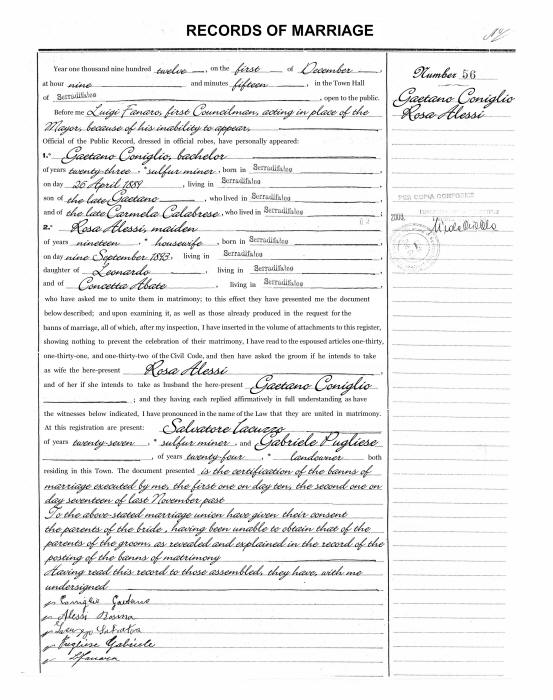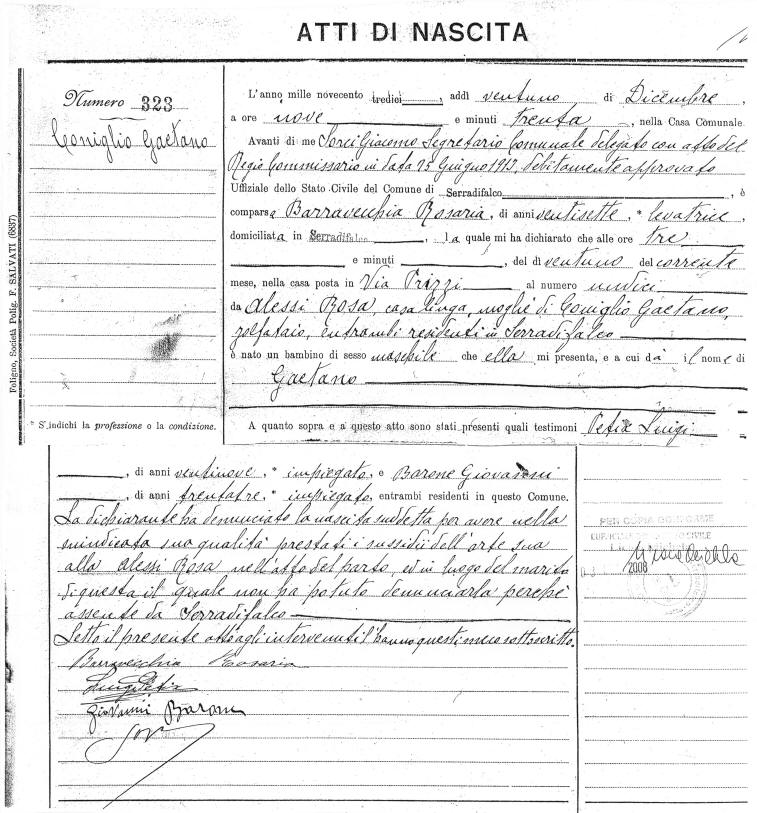Often, novice researchers have a difficult time determining the
'maiden names' of their female Sicilian or Italian ancestors.
This is compounded by a lack of knowledge of the naming customs in
many European lands, including Sicily and Italy. And a
commonly asked question is "Wasn't my grandmother married before
she came to the U. S.? On her passenger manifest, her surname
is different than that of her children."
The answer is simple: in
Sicily and Italy, early on, the term 'maiden name' was not commonly
in use.
They were not used as such, and
that is generally the case, even today. A woman was
known, familiarly and officially, by her BIRTH surname, that is, the
surname of her father.
For example, Rosa, the daughter
of Leonardo Alessi, was Rosa ALESSI.
When she married Gaetano Coniglio, her name remained the same:
Rosa Alessi. When her first
son Gaetano CONIGLIO was born,
his record of birth gave his mother's name as
Rosa Alessi. When she emigrated to
America, the name on her Italian passport was
Rosa Alessi, and she was listed by
that same name, Rosa Alessi, on
the passenger manifest of the ship on which she travelled, even
though below name her was her son's, identified as
Gaetano CONIGLIO.
If Rosa Alessi had remained in
Sicily, she would have been called Rosa
Alessi for her entire life. If she had died
there, her record of death would have been indexed under the letter
'A' and her name would have been recorded as
Rosa Alessi. The headstone on her
grave would have read Rosa Alessi.
If reference to her
husband's surname was necessary for some reason (say, distinguishing
her from her cousin Rosa Alessi, who had married Vincenzo
Abate) she would be referred to as "Rosa
Alessi in Coniglio", meaning
"Rosa ALESSI, married to a man with the
surname Coniglio". This is converse to the American
custom of saying "Rosa Coniglio NEE
Alessi".
The great majority
of the thousands of women's names the author has viewed on passenger
manifests showed the women's birth surnames. That was how
their visa or passports were filled out, and how they were listed on
the manifests. Most that I've viewed were from the regions formerly
comprised by the Kingdom of the Two Sicilies, both mainland and
insular, but also include others from the North of the Italic
Peninsula. A woman's children travelling with her might
be listed with their father's surname, or the field might be left
blank. That practice has led to many cases in which modern
indexers assume incorrectly that the children's surname is the same
as their mother's. In some cases a woman's husband's surname
may be "penciled in" over her surname in a different handwriting,
indicating that it had been added after her arrival.
Once in America and other
English-speaking countries, local
custom took over, and Sicilian women became known by their husbands'
surnames. Thus, in the United States, my mother went from
Rosa Alessi to "Mrs. Gaetano
Coniglio", or "Rosa Coniglio".
Rosa Alessi was my
mother. Below are records of her life events, showing how her
name remained unchanged, before she settled in America.
My mother didn't
remain in Sicily, but her sister Maria Alessi did, and she married a
man named Andrea Salvo. My Aunt Maria died
in Sicily in 1974. Her headstone in the Cimiterio di
Serradifalco reads "ALESSI MARIA
VED. SALVO",
meaning "Maria Alessi, widow of [Mr.]
Salvo". An image of her headstone follows my
mother's records below.
Knowledge of
the Sicilian custom will help to understand what seem to be
inconsistencies in womens' surnames. It can also be useful in
the following situation: if you know that say, your grandparent
emigrated as a child with his/her mother, and you know his or her
name, but not the surname of his/her mother, you can search
passenger manifest lists for your known grandparent. If you
locate your
grandparent's manifest, on the line above their name will be the
'maiden name' of your great-grandmother! And remember,
if you search for a female ancestor's or other female relative's
Sicilian record of death, her record will be indexed by her birth
surname.
3pt |










